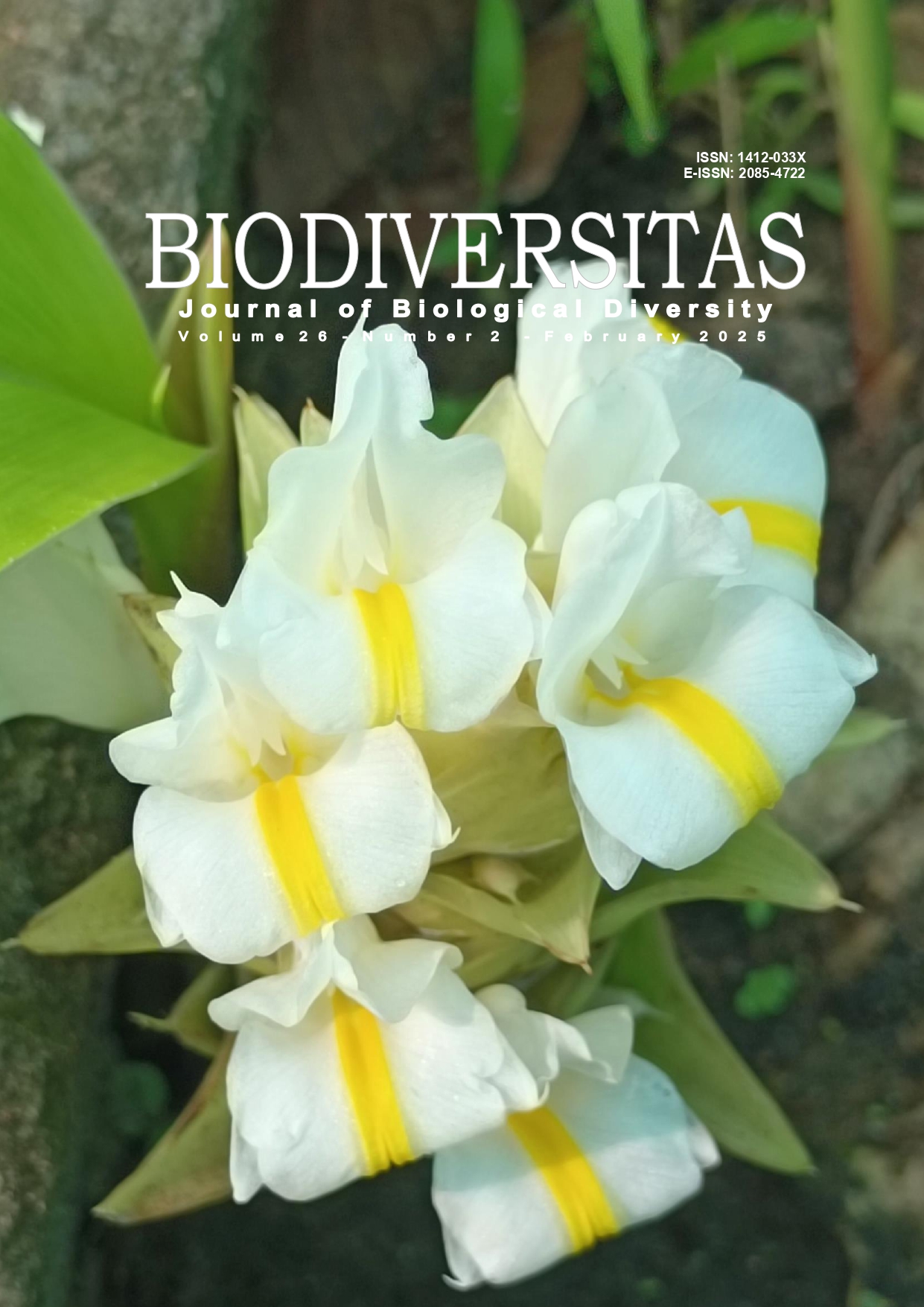Diversity and phenetic relationship of lichen genus Usnea in Cisanti Forest area, Bandung District, West Java, Indonesia
##plugins.themes.bootstrap3.article.main##
Abstract
Abstract. Kusmoro J, Raihan R, Hermawan W, Hasan R. 2025. Diversity and phenetic relationship of lichen genus Usnea in Cisanti Forest area, Bandung District, West Java, Indonesia. Biodiversitas 26: 583-600. The Cisanti pine forest in Bandung District, West Java, Indonesia, is the area of an educational eco-agrotourism area and is a natural habitat for Usnea. However, there is no report yet about the richness of Usnea in this location that is important to provide information such as its biodiversity and chemical content beneficial resources. This study aimed to explore the diversity and analyze phenetic relationships of Usnea in the Cisanti forest area, based on morphological, anatomical, and chemical characters. The sampling method was carried out by exploring the forest area purposively on pine trees that Usnea grew. Usnea’s phenetic relationship was analyzed using the NTSYS version 2.01e software. The results showed 23 species of Usnea were found, namely U. angulata, U. baileyi, U. barbata, U. ceratina, U. chaetophora, U. cornuta, U. dasaea, U. diffracta, U. flammea, U. flavocardia, U. hirta, U. lapponica, U. maculata, U. mutabilis, U. pangiana, U. robusta, U. rubicunda, U. shimadae, U. sinensis, U. steineri, U. subcornuta, U. subflorida, and U. wasmuthii. Based on the 41 characters analyzed, in general Usnea divided into 3 clusters and cluster separation corresponds with subgenera, namely Usnea, Eumitria, and Dolichousnea. The closest relationship is between U. sinensis and U. maculata, and between U. barbata and U. lapponica by a similarity index of 0.814. The most distant relationship is between U. baileyi and U. barbata and between U. angulata and U. chaetophora, as well as U. subcornuta and U. pangiana by a similarity index of 0.616.
##plugins.themes.bootstrap3.article.details##
Most read articles by the same author(s)
- JOHAN ISKANDAR, JOKO KUSMORO, MIRA MUBAROKAH, RUHYAT PARTASASMITA, Ethnobotany of banana plants (Musa x paradisiaca) of Palintang Hamlet, Cipanjalu Village, Bandung, West Java, Indonesia , Biodiversitas Journal of Biological Diversity: Vol. 19 No. 6 (2018)
- PUTUT FAJAR ARKO, BETTY MAYAWATIE MARZUKI, JOKO KUSMORO, The inventory of edible mushroom in Kamojang Nature Reserve and Nature Park, West Java, Indonesia , Biodiversitas Journal of Biological Diversity: Vol. 18 No. 2 (2017)
- JOKO KUSMORO, BETTY MAYAWATIE, RULLY BUDIONO, IIN SUPARTINAH NOER, RIRIN EKA PERMATASARI, ALISA NURWAHIDAH, RIKA SATRIAWATI, DIAH ARUM, DORA ERAWATI SARAGIH, RIA WIDYA, MUHAMAD FEISAL JATNIKA, AFIF MAKARIM, RUHYAT PARTASASMITA, Short Communication: Species diversity of corticolous lichens in the arboretum of Padjadjaran University, Jatinangor, Indonesia , Biodiversitas Journal of Biological Diversity: Vol. 20 No. 6 (2019)
- IRA ROBIBATUL CHOIR, JOHAN ISKANDAR, PARIKESIT PARIKESIT, RUHYAT PARTASASMITA, TEGUH HUSODO, JOKO KUSMORO, ERRI NOVIAR MEGANTARA, The local management and sustainability of swidden farming in the Villages of Bojongsalam and Sukaresmi, Upper Cisokan Watershed, West Java, Indonesia , Biodiversitas Journal of Biological Diversity: Vol. 19 No. 3 (2018)
- MOHAMAD NURZAMAN, TIA SETIAWATI, RUSDI HASAN, NAZLA KARUNIA QOTRUNNADA, JOKO KUSMORO, NANDANG PERMADI, EUIS JULAEHA, The phenetic relationship of citrus plants based on the morphological and anatomical characteristics , Biodiversitas Journal of Biological Diversity: Vol. 25 No. 3 (2024)
- ASEP ZAINAL MUTAQIN, MARZHAVIRA AZLIKA KHRISNAN, JOKO KUSMORO, JOHAN ISKANDAR, RULY BUDIONO, MADIHAH, MOHAMAD NURZAMAN, TIA SETIAWATI, RUSDI, Morphology of porang (Amorphophallus muelleri) in the Citarum Watershed, West Java, Indonesia , Biodiversitas Journal of Biological Diversity: Vol. 25 No. 8 (2024)
- TEGUH HUSODO, INDRI WULANDARI, YOLANI SYAPUTRI, HIKMAT KASMARA, WAWAN HERMAWAN, JOKO KUSMORO, SYA SYA SHANIDA, FADIAH KHAIRINA, M. RIFKY ALIF HAYDAR, M. NAUFAL ASYRAF, RIFKY ROCHIMAT FEBRIAN, Blooming calendar and polliniferous plants in Djuanda Great Forest Park, West Java, Indonesia: Implication for beekeeping management , Biodiversitas Journal of Biological Diversity: Vol. 25 No. 7 (2024)

